|
The World's Finest Presents 
THE WORLD'S FINEST MAIN PAGE · SITE SPECIALS · EDITORIALS · FORUM
Bring on the Bad Guys: The Possible Return of Batman: The Animated Series, Part 4
By Joseph Davis
NOTE: On May 19, 2021, it was announced that the rumored BTAS reboot would take the form of a new animated series titled Batman: Caped Crusader, of which Bruce Timm, J.J. Abrams and Matt Reeves will be executive producers. However, aside from the name and the fact that Bruce Timm is involved, virtually nothing else is known. With that in mind, I will continue to write these essays, speculating on how this series may play out if it is, in fact, a true continuation of the DCAU.

In an epilogue essay published in Wizard Magazine’s The Dark Book, Vol. 1 (1994), writer Peter David reflected on how heroes and villains have switched places in the transition from classic fiction to today’s superhuman (or posthuman) fiction. For example, in traditional heroic fiction, “the young hero would leave the safe confines of his rural house, embark upon a great quest, encounter formidable villains who stood between himself and his goal, overcome the villains, and return home with riches / wisdom / a bride. […] Consequently, superheroes have one purpose and one purpose only: to stop the villains.” Meanwhile, it’s the bad guys that have assumed the role of the classic protagonist: “It is the villains who are the movers and shakers. The villains plan and scheme, conspire and machinate. It is the villains who have the goals, the dreams, the long-term desires for […] riches, the girl, fame, power—all the things, in short, that the heroes of yore strove for.” The best episodes of Batman: The Animated Series provide validation to this theory: "Heart of Ice,” “Feats of Clay,” “Two-Face,” “Harley & Ivy,” “Birds of a Feather,” “Harley’s Holiday”…this list goes on. Simply put, in comic books, the bad guys are vital—they initiate plot and heavily contribute to rising action—and without them there’s no story (and no reader interest). Fortunately for us, the Dark Knight has one of the best Rogues’ Galleries in comics, and they would play a pivotal role in any potential BTAS reboot.
Gotham City is a creation rife with complexity; a character in itself. Modelled after New York City, Gotham is in fact an exaggerated version of the Big Apple, a fictional creation of a caliber perhaps rivaled only by The Simpsons’ Springfield. It literally has everything and anything a Batman story could need in terms of setting. My favorite description of Gotham comes from Batman / Planetary: Night on Earth (2003), where writer Warren Ellis described the city as being as “[o]ld as New York, founded on the East Coast and originally designed by English Masons on opium…exacerbated by absinthe-fiend local architects in the twenties, basically not suitable for human habitation.” However, while it may be easy to pigeonhole Gotham City as merely a nightmarish urban hellscape—an equal combination of the worst aspects of Baltimore, Detroit, and St. Louis—to do so would be a disservice to the Dark Knight. As writer Grant Morrison said in a 2009 Gizmodo interview:
That whole Son-of-Sam, Rorschach-narration—‘This city is an open sewer where the rats feed on the broken dreams and filth of umm…other rats…where sneering, gnawing urban predators…blah blah…’—has become clichéd, tired and unconvincing. If Gotham was so bloody awful, no-one normal would live there and there’d be no-one to protect from criminals. If Gotham really was an open sewer of crime and corruption, every story set there would serve to demonstrate the complete and utter failure of Batman’s mission, which isn’t really the message we want to send, is it? You’ve got Batman and all his allies as well as Commissioner Gordon and the city still exudes a vile miasma of darkness and death? I can’t buy that. It’s simply not realistic and flies in the face of in-story logic (and you know I like my comics realistic!), so my artists and I have taken a different tack and we want to show the cool, vibrant side of Gotham, the energy and excitement that would draw people to live and visit there.
Gotham needs as many faces as Batman—it should be the loudest, sexiest, jazziest city on Earth. It has the best restaurants, the best theaters, the best art, the best criminals, the best crimefighters, etc etc. People put up with the weird crime for the sheer buzz.
In an earlier joint interview with writer Paul Dini from Wizard Magazine #178 (August 2006), Morrison also compared Gotham to another infamous American city: “I was in [Las] Vegas for the first time last year and suddenly thought, ‘This is Gotham, this is the way it should feel, this is what happens when crime runs a city.’” And it is with this backdrop in mind, it is not impossible to see how this came to influence crime in Gotham—the loudest, sexiest, jazziest city on Earth. In fact, it would be the perfect setting to produce a new class of criminal.
On BTAS, with its attempts to humanize the villains Batman faced, the majority of the villains’ origin episodes took the form of them experiencing a sort of Falling Down-moment where the system failed them, and—whether at the hands of Rupert Thorne (Two-Face), Ferris Boyle (Mr. Freeze), Roland Daggett (Clayface), Daniel Mockridge (the Riddler), or, perhaps, modern society itself—these characters, brought low, sought out their revenge in the showiest way possible. As Dini recounted in an interview with Animation Arena (see here):
I think the villains are really consumed with personal pain, and that pain sort of stimulates a sense of the theatrical and the wicked in them. Whether it’s Gotham City or whether it’s just a reaction to Batman’s existence or whatever, you don’t just become a guy who knocks over a liquor store in Gotham City if you’re angry with your life. You go out, you get a costume and a gimmick, and you live that life to the fullest. I was looking at how some people would take sadness, sorrow, bitterness, or anger in their life, and how [those] would manifest [themselves] if you were going to become some exotic super-criminal.
And the citizens of Gotham ate it up. Our society has always been fascinated by those we’ve deemed criminals. Billy the Kid, John Dillinger, Al Capone, John Wayne Gacy, Charles Manson—all popular examples from a long, long list. And whether we are Depression-era sharecroppers cheering criminals robbing banks or present-day citizens pouring over podcasts about serial killers, we cannot deny that interest and, over time, these malcontents get elevated to the rank of celebrity. In the same aforementioned Wizard interview, Dini recognized this, stating, “I look upon Gotham City as being kind of celebrity-crazy in that way that they’ve had so many masked criminals come through they’ve almost become kind of a tourist attraction: ‘Come here and you might run into the Scarecrow!’” In the world of BTAS, one could argue that—in our advertising-driven, logo-saturated world—the costumed supervillain is the natural progression of this evolution, and Gotham City was ground zero of this change.
Alan Moore recognized this early on. In his two-part story “Night Olympics” (Detective Comics #549-550, April & May 1985), Green Arrow—after an evening of underwhelming crimefighting—had the following observation:
Superheroes have really screwed things up for the criminal classes in this country. […] It’s like all the fight’s gone out of the ordinary criminal. Ordinary criminals just can’t complete anymore. […] We’re gradually weeding out all of the just-plain-average goons, gradually improving the strain…until only the flat-out-dangerous psychos are left in the running.
While it was never overtly spelled out, BTAS shows a perfect example of this “Criminal Darwinism” in action. In the beginning, Batman primarily fought common crooks and gangsters. Joker and Penguin were around (they never had origin episodes), but they were aberrations. In fact, one could argue that his biggest foes then were crime boss Rupert Thorne and industrialist Roland Daggett. Then came the first wave of costumed supervillains—Catwoman, Two-Face, Poison Ivy, the Riddler, Clayface, and the rest—and, suddenly, the old guard started disappearing (obviously the Fox and Kids’ WB mandates to focus on supervillains had something to do with it too, but I digress). By the time TNBA rolled around, it was all costumed villains, all the time (Thorne attempted to make a comeback in 2003’s Batman: Mystery of the Batwoman, but that ended in failure).
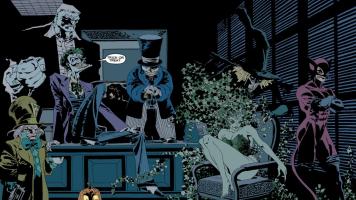
This “natural selection” was more explicit in the comics. The recent Three Jokers miniseries (2020) spoke of the Joker killing off the mob, echoing his statement in 2008’s The Dark Knight: “This town deserves a better class of criminal, and I’m gonna give it to ‘em.” Paul Dini played with this transition in his Batman stories—for example, in his House of Hush story arc (2010), recently-released convict Judson Pierce reflected, “I hear crime’s a new game now…freaks and monsters running the show. Guys like me, the old-time fedoras, all dead and forgotten.” And, of course, there was The Long Halloween (1996-1997), where—over the course of a year—members of the Falcone and Maroni crime families are picked off, one by one, by a killer known only as Holiday. This culminates into a showdown between Carmine “The Roman” Falcone and Gotham’s costumed criminals, resulting in the torch being passed to a new kind of bad guy.
By the time of our proposed BTAS reboot, the costumed supervillains have been in charge of Gotham City for several years. But evolution marches on, new threats emerge, and natural selection weeds out the weak. What happens when the next generation of criminals arise and they attempt to stake their claim on the city?
This essay will take a look at the existing Rogues’ Gallery, speculate on where they may be in a potential reboot, and then guess about who (or what) may show up next. Please note that the Joker and Harley Quinn will not be addressed here as, like Batgirl, they deserve special consideration.
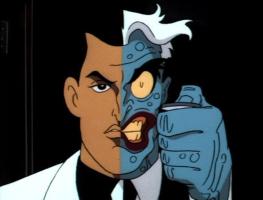 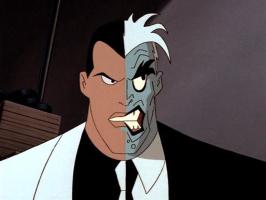
Two-Face
One of the few characters to emerge virtually unchanged from the TNBA transition was Harvey Dent, better known as Two-Face. Voiced by Richard Moll, we watched as the young district attorney took on two enemies: mob boss Rupert Thorne, as well as Dent’s submerged second personality, that of “Big Bad Harv.” After being caught in an explosion that mutilated 50% of his body and brought his two personalities together, they rechristened themselves as Two-Face and vowed to take down Thorne…only this time as a competing crime boss. Eventually toppling his rival in the two-part episode “Shadow of the Bat” (with the help of Deputy Commissioner Gil Mason), I propose that—in the BTAS reboot—Two-Face is the dominant criminal in Gotham City (second only to the Joker, of course), as he used his knowledge of the criminal underworld and Gotham politics to amass an empire larger than Rupert Thorne ever could imagine. In BTAS, he was merely a young upstart, but here he’s become the establishment.
(Of course, one would need to consider what type of crime would be focused on here. For example, would casino gambling or marijuana possession be a crime, or would Gotham City be located in one of the states that have legalized them? For our purposes, Two-Face’s empire would most likely encompass prostitution, extortion, fencing, hijacking, theft, drugs, and gambling in some form.)
Of course, a mob boss needs a mob, and Two-Face would amass a fine one. I see them as decked out in black and white suits (not bifurcated like his, of course), with the captain of each gang assigned a two-faced coin similar to the original, and it’s pulled out to make big decisions (“You’re late with your protection money. Good heads, we let you off for the month. Bad heads, we burn down your shop.”). In addition to his foot soldiers, Two-Face would ally himself with several of his criminal contemporaries—including Penguin, the Mad Hatter, and Killer Croc—whose gangs pay tribute and offer additional muscle, if needed, in exchange for protection.
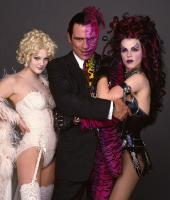
Another possibility for the gang—in the tradition of Harley Quinn and the Penguin’s henchwomen Raven, Lark, and Jay—could be the DCAU debuts of Sugar and Spice, from Batman Forever (1995). Of course, they would be more than mere arm candy, doing double-duty as his personal bodyguards. Keeping with the gangster / film noir look, I would recommend redesigning them to resemble classic ‘40s femme fatales, with Sugar designed to resemble actor Marilyn Monroe, while Spice would be a tribute to classic pin-up model Bettie Page. They would be decked out in white and black dresses, respectively, as per the gang’s motif.
By making Two-Face the boss of bosses, it would make him a major presence in the reboot, as well as a stronger villain for Batman, considering their former friendship as Bruce Wayne and Harvey Dent and his turn from D.A. to crime boss. It could also answer some additional questions. For example, is Two-Face in constant pain from his injuries (requiring painkillers), or did the injury fry his nerve endings? Does he require regular doses of antibiotics to prevent infection? Does the damage actually cover the entire left half of his body? Also, considering the increased importance of pronouns in today’s world, would the criminal prefer “we” instead of “I,” or “they” instead of “he?” Hell, could the man who values duality be bisexual (“Good heads, we go home with Sugar and Spice tonight. Bad heads, we go home with that cute waiter who was giving me the look.”)? And, if he was (they were), how would he (they) handle homophobia in his (their) organization (“Good heads, you go in for sensitivity training. Bad heads, we bury you in that field outside of town.”).
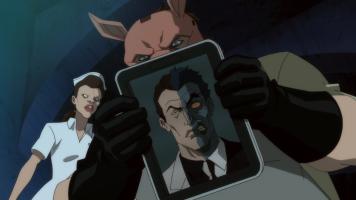 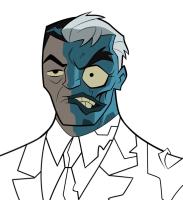 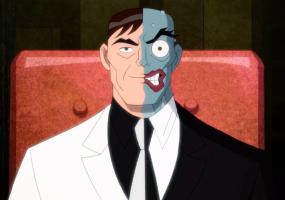
There’s also the possibility that the creative team might try their hand at a second revision of his (their) look. In terms of design, I wouldn’t change much—the classic black-and-white suit has proved so popular that it has been adapted occasionally in the comics and copied in other animated shows and movies. If I were to make any recommendations, perhaps they could add back some “character” to his face (compare the above photos—note the detail on his BTAS visage, as well some remaining humanity in his right eye).
Of course, in addition to Batman, the Number Two criminal in Gotham would also have to deal with rival, up-and-coming crime bosses, which we’ll discuss later. At any rate, in this proposal, Two-Face would be the men to beat.
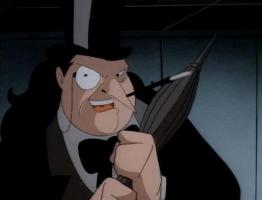 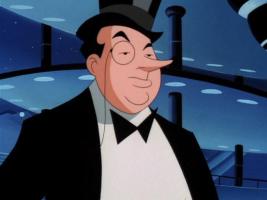
The Penguin
In contrast to Two-Face, the Penguin underwent a radical redesign as BTAS shifted to TNBA. No longer the mutant bird-man created for Batman Returns (1992)—which has been revisited in the comics as of DC’s 2011 New 52 reboot—for the Kids’ WB relaunch, Oswald Cobblepot reverted to his classic, Golden Age appearance (is it just me, or does his face resemble Franklin Roosevelt’s?). There has been much debate over the years as to how this change came about—in a recent Batman: The Adventures Continue story arc, writers Paul Dini and Alan Burnett wrote this off as the result of surgeries obtained after a violent encounter with Jason Todd’s Robin. I suppose this works, but it doesn’t explain why Cobblepot would seek to change his distinctive appearance if he were looking to cash in on his years as a costumed supervillain.
On the surface, the Penguin is the Batman villain who sold out. Always touting his status in high society in the early days (see “Birds of a Feather”), the old bird apparently decided to do just that, molting his villainous past and opening the Iceberg Lounge, which quickly became one of Gotham City’s hot spots, finally allowing him to mingle with Gotham’s elite. This was, however, just a front, allowing the Penguin to establish himself as a valuable underworld contact, specializing in arms dealing (Batman: Mystery of the Batwoman) and fencing stolen goods (“The Ultimate Thrill,” “Judgement Day”).
Of course, a criminal like the Penguin would hardly put all his eggs in one nest, as the Iceberg Lounge would allow him to partake in a more legit form of crime. In Detective Comics #824 (December 2006), Cobblepot regaled the Riddler with his master plan: “Suckers pay big money to rub elbows with dangerous celebrities. Makes them feel ‘cool.’ […] I’m negotiating to open satellite Iceberg [Lounges] in Metropolis, L.A., and Vegas. All legit, with all profits going to me!” And while selling overpriced drinks and memorabilia is a fine grift, in a BTAS reboot I could see the Penguin expanding his operations, moving into casino gambling.
Initially only legal in certain areas of the United States (Las Vegas, Atlantic City, Native American reservations, etc.), in recent years commercial casinos have been popping up all over the country. Currently eighteen states have them, and—assuming Gotham City is in one such state—I could not see how the Penguin would not get in on the ground floor. I could see Oswald Cobblepot opening The Iceberg Lounge & Casino in silent partnership with Two-Face, allowing him to launder money from his criminal empire. Any previous grievances (“Second Chance”) would most likely be forgotten due to the sheer volume of profit being generated. Meanwhile, the Penguin could diversify his holdings by fencing goods ranging from precious gems to exotic weaponry (like the Vulture in Spider-Man: Homecoming; I’m sure there’s lots of Thanagarian and Apokoliptian weaponry lying around after both invasions).
Bringing the Penguin to the forefront of the reboot might also give us a look into the character’s history. As previously stated, the previous shows never really delved into his backstory. Were the Cobblepots a wealthy family that fell into poverty, or was that merely a con perpetrated to give him an air of elegance? What was it like to grow up with his deformity? What were the circumstances behind his cosmetic surgery? These questions could be addressed.
As for his appearance, I would prefer they stay closer to the TNBA “Golden Age” look, though they may make a few adaptions to update it (abstract triangles for a bowtie may work for the Joker, but not so much the Penguin). I also wouldn’t mind the return of his cigarette holder and, since this would be on HBO Max, we might actually see him smoking with it, rather than just holding it in his teeth. And, on a final note, the return of Paul Williams to perform the voice is a necessity.
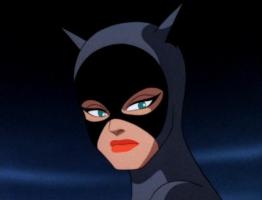 
Catwoman
Like the Penguin, Catwoman was another character whose appearance was beholden to Batman Returns (1992), with her classic dark hair traded in for blond, allowing her to better resemble actor Michelle Pfeiffer. On the other hand, her BTAS outfit didn’t resemble the movie’s costume at all, harkening instead to Frank Miller’s gray suit from Batman: Year One (1987) with some Silver Age flourishes (the gold belt) thrown in. This was done because Bruce Timm feared that a black catsuit wouldn’t show up well with the series’ Dark Deco art style. This would end up being a metaphor for the character, as this was merely the first of many concessions to get Catwoman to fit into the original BTAS series.
At her best, Catwoman—voiced by actor Adrienne Barbeau—is the archetypical femme fatale. She does, however, have a conscience, choosing to steal only from the rich (or, depending on the story, other criminals). Her relationship with Batman is complicated, with their mutual attraction forcing him to make compromises because—despite her heroic leanings and adventurous spirit—she is a thief and will always be one (during a recent story arc where Batman and Catwoman were planning to marry, she stole her wedding dress). However, following the excellent “The Cat and the Claw” two-parter, where this relationship was explored, our resident cat burglar found herself arrested and threatened with jail time. As a result, Selina Kyle was reduced to playing Bruce Wayne’s love interest and Batman’s damsel in distress (“Tyger, Tyger,” “Cat Scratch Fever,” and “Almost Got ‘Im”) for the duration of the original series. Suffocating from being on a short leash, she returned to her criminal ways in “Catwalk,” setting up for her appearances in TNBA, where she returned to her brunette roots and, ironically, a more Batman Returns-inspired costume.
The trick with Catwoman is to find a happy medium between “master cat burglar” and “costumed adventurer” that Batman would not try to immediately shut down, allowing for that simmering flirtation and occasional team-ups. Perhaps, in the years between TNBA and the proposed reboot, a deal was struck, either directly or through implied consent, where Batman would leave Catwoman alone provided that…
1. She does not commit criminal acts in Gotham City.
2. She only steals from other criminals.
3. She continues to use her wealth to fund her environmental charities and other good works.
I could see Selina Kyle agreeing to this. If Gotham City were her home base, it would be stupid to commit crimes where she could be easily caught (as the saying goes: you don’t shit where you eat), so here she would go out of town to find her thrills, targeting wealthy criminals and even stealing already stolen items to return them and claim a bounty. By slightly tweaking her modus operandi, this would allow her to build that tension between her and the Dark Knight, as well as open her up to team-ups with other characters. Perhaps we can finally get that Catwoman / Black Canary team-up that never happened.
On another note, I would love to see a sequel to “Tyger, Tyger,” the episode where Selina Kyle was transformed into a literal cat woman. This makes her an early example of a “splicer,” a term coined for Batman Beyond for human / animal hybrid characters, of which the DCAU has had many (Man-Bat, Copperhead, etc.). Perhaps Batman and Catwoman could investigate the arrival of splicing in Gotham City, allowing them to go up against Dr. Emile Dorian, Dr. Abel Cuvier (from Batman Beyond’s “Splicers”—Dini established him as Dorian’s “young assistant” in 2018 Harley Loves Joker miniseries), and Cheetah, who was established in Justice League’s “Injustice for All” as a splicer herself. A Catwoman / Cheetah “cat fight” would be welcome, as would an appearance by Dini-created comics character the Grison (from the aforementioned Harley Loves Joker miniseries). Bonus points if Dr. Kirk Langstrom (and Man-Bat) returns, as he was sorely underused in BTAS.
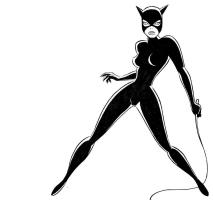 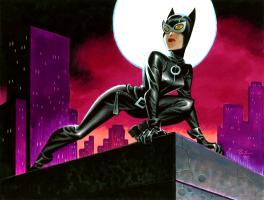 
In terms of design, as much as I like the TNBA costume, it does make her look like less of a human woman and more like a cartoon character. There are options, however: a happy medium could be found by returning to the design created for the aborted Catwoman spin-off, which the creative team tossed around in 1993-1994 before shelving it and moving on. It’s essentially the TNBA design, but it’s less cartoony, and it allows you to see her eyes, like in the BTAS version. Another possibility could be found in the costume designed by Darwyn Cooke for his 2002 Catwoman ongoing series, which proved popular enough to be used in the comics for nearly twenty years.
Catwoman is a character filled with complexity that, sadly, was stripped down for the simplicity of network television. Hopefully an animated series HBO Max could return some of that nuance to Ms. Selina Kyle.
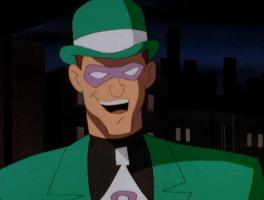 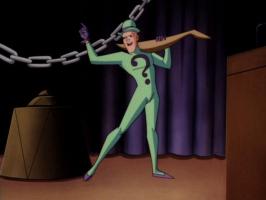
The Riddler
Edward Nygma, better known as the Riddler, is a complicated member of Batman’s Rogues’ Gallery. A minor Golden Age villain, he would earn his status as a major player primarily due to the strength of character actor Frank Gorshin’s portrayal of him in the campy 1960s Batman series. Compared to his Arkham contemporaries, the Riddler is practically a gentleman thief, a figure of style and decorum more interested in matching wits with the Dark Knight rather than racking up a body count. He is, however, not without his supporters—in an October 2006 Wizard Magazine interview, Paul Dini said, “[h]e exists on the same cerebral plane that Batman does. Just as Batman is very analytical and very methodical in his crime-solving procedures, so is the Riddler just as cerebral in the traps he lays for Batman.” Unfortunately, the criminal mastermind found himself the victim of his own methods when it came to BTAS.
According to Dini, as recorded in Batman: Animated (1998), the Riddler was a “constant frustration” to the creative team as they struggled to make the character work:
[T]he Riddler […] seems to work better in comics than he ever has in animation. In a comic book, mystery novel, or live-action drama the writer has the luxury of time to set up and solve a brain-wracking crime. In a twenty-two-minute cartoon, the action has to keep moving, and gimmick-heavy characters like the Riddler have to make their point quickly and get on with it. Quite often the only thing propelling a Riddler story was the cleverness of his riddles and traps, and if they weren’t particularly original, the episode turned into a snooze. […] There are at least half a dozen full or partially completed Riddler stories in our dead script file that proved ultimately too complex or too silly to produce.
As a result, the Riddler was reduced to a mere three episodes, as well as an immobile, silent cameo in “Trial.” And, when it came time to redesign the character for TNBA, the creative team apparently decided to act upon that frustration, swapping his slick BTAS suit and tie for a lime green bodystocking and purple ballet slippers, as well as reducing his screen time to quick cutaways (his only real appearance during this era was in the Superman episode “Knight Time.”). For a formidable threat like the Riddler, this was a humiliating way to end his tenure in the DCAU.

While a footnote in Dini’s animated shows, the Riddler fared much better in the writer’s comic books, acting as a recuring character during his run in Detective Comics (2006-2009) and Gotham City Sirens (2009-2010) by retiring from crime to reinvent himself as a private investigator. Said Dini in the aforementioned Wizard interview, “The Riddler thinks, ‘Why should I waste all my time fighting Batman when there are wealthy idiots who will spend big money for me to solve cases for them? I can name my own price!’” This permitted him to continue his battle of wits with Batman, only this time he was in competition with him to solve the crime. Dini continues: “If Batman is Sherlock Holmes, then the Riddler is this very aggressive, jealous and hateful Inspector Javert.” This would work in a potential BTAS reboot; in fact, it was already successfully demoed in “E. Nigma, Consulting Detective,” a 2017 episode of Justice League Action. In fact, it worked so well that I would encourage the creative team to grandfather this version of the character in.
 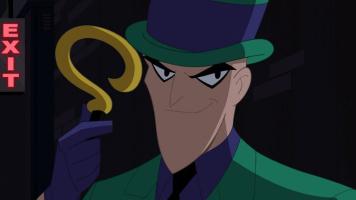
Now, don’t get me wrong—I love the BTAS version of the Riddler. Voiced by John Glover, he was an excellent figure of quiet, calculating menace, but his characterization came off as just a little too smug and self-absorbed. The version from Action still has that quality, of course, but it’s dialed back slightly, and it’s replaced with a playfulness and energy that melds together the best qualities of Glover’s BTAS Riddler with Frank Gorshin’s. It is a credit to actor Brent Spiner (Data from Star Trek: The Next Generation) that he was able to make such an impression in a single appearance. I want to see this version of the Riddler attempting to steal the limelight from Batman by upstaging him at his own game while, at the same time, struggling with the itch to return to crime.
In terms of appearance, this version keeps the shaved head of the TNBA design (not a bad look for him, actually), while thankfully returning him to the dignity of being a sharp dressed man (with a nicer walking stick). My only suggestion: return the single question mark to the tie (from the BTAS design), while continuing to resist the urge to put him in the tacky question mark jacket and hat from the comics. Leave that look for Matthew Lesko.
 
Poison Ivy
Considering her popularity today, it’s easy to forget that Dr. Pamela Lillian Isley, better known to Batman fans as Poison Ivy, was a B-list villain until BTAS debuted in 1992. Debuting in Batman #181 (June 1966), she started out as a temptress who used her skills in botany and chemistry, as well as her immunity to poisons, to embark on a life of crime, using her pheromones and toxins to manipulate men into doing her bidding (it is through this talent that she became infatuated with Batman, who was difficult to control). Later she gained her ability to control plant life and, in the 1980s, DC writers (notably Neil Gaiman) wove her into Swamp Thing’s mythology, giving her a connection to The Green, an elemental force that connects all plant life on Earth. However, it wasn’t until BTAS that the character gained national attention and became a major media presence.
In fact, it was BTAS that introduced many of the trappings of the character that people identify, such as her eco-terrorism and, more importantly, her relationship with Harley Quinn. Debuting in the 1993 episode “Harley and Ivy,” the duo rapidly became a fan favorite, frequently appearing together both in animation and the comics. However, while their “are they, or aren’t they?” relationship status was hinted at for years, their romance didn’t become overt until 2011’s New 52 revamp, where they became both a non-monogamous couple and queer icons, but while the attention has certainly been a boon to Harley, it has caused significant problems for Ivy.
In recent years DC Comics (and its parent companies) have waffled in regard to Poison Ivy’s characterization. For example, Ivy has also become part of the recent trend of taking comic book villains and turning them into antiheroes, such as in 1999’s No Man’s Land storyline, where an earthquake decimated Gotham City, and she did her part by sheltering orphaned children in Robinson Park and providing food to the destitute. Meanwhile, other stories still paint her as a classic villain, such as in Detective Comics #823 (November 2006) where, in a tale penned by Dini, we discover that Ivy’s hobby is luring people home to feed them to her giant, carnivorous plants. And, as for Harley Quinn, DC Comics was initially okay with the pairing until they weren’t. The website Bleeding Cool has done a fine job of detailing how DC Comics has shifted them away from each other, even as the mega-popular Harley Quinn HBO Max series shows them forging a new relationship in Season Two. In fact, things have gotten so complicated that, in 2019’s Harley Quinn and Poison Ivy miniseries, it ended with two Ivys—one villainous, one antihero—literally at war with each other.
In terms of her characterization in a proposed BTAS reboot, I say we go back to Paul Dini for insight into the character. In a 2009 interview with Comic Book Resources (see here), he that Poison Ivy “lives for the moment doing exactly what she wants because she’s powerful enough and self-centered enough to do it. Other than plants, she only cares about herself and the few people she lets in, such as Harley.” In a Wizard Magazine #176 (July 2006), he expanded on this take:
When I was working on the show, I always got a lot of people asking me, ‘Is Poison Ivy gay?’ I don’t think you can limit it to that narrow a scope. I think that Ivy is the total sensualist and hedonist who lives for pleasure in whatever form it takes, whether it’s man, woman, plant, animal or mineral. She does things because they feel good and amuse her. She’s got no limits and likes getting inside people’s heads until they’re just as mad as she is.
And I feel that should be the take on Ivy in the reboot—to focus on the hedonist, environmentalist, and criminal sides of the character. Also, it is worth mentioning that, despite the collective shipping of Harley and Ivy as a couple, they’ve never been one in the DCAU, only friends. And while I see no problem with Poison Ivy as an LGBTQA+ icon—seducing men and women to get her way—I feel that the pairing with Harley Quinn does more to contribute to Quinn’s world than to Ivy’s. Besides, in terms of animation, fandom already has Harley and Ivy together in the Harley Quinn animated series, which has a third season coming. So why copy ourselves?
In the proposed reboot, I could see Poison Ivy being allied with Two-Face (despite their rocky history), supplying his organization with homegrown drugs, using her manipulation powers to sway key government officials, and disposing of bodies (more mulch for the garden). She would be, of course, paid handsomely for her efforts, and would most likely use that money to purchase rainforest land to protect it from developers. In fact, this could be a lead-in for the future—in ToyFare Batman Special: Batman Beyond—What You Didn’t Know About the New Batman (1999), Dini speculated about her eventual fate:
She moved to South America and took over the rain forest. Actually, she’s now part of the rain forest. We were thinking that she had mutated into some sort of quasi-human / quasi-plant-based form of life and moved to South America.
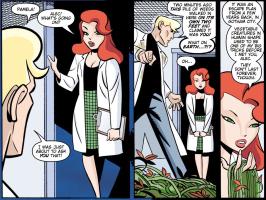
This is, of course, assuming that our Ivy is the original Poison Ivy. In “Flower Girl,” a short story in Batman Adventures #16 (September 2004), writer Ty Templeton revealed that the TNBA Poison Ivy was a plant-based construct in human form, left behind by the BTAS Poison Ivy when she departed Gotham City (presumably after “House & Garden”) so Batman would not come looking for her. Perhaps this could be adapted for the reboot, with the new Poison Ivy discovering that she is not the original Ivy. How would she react? Would she seek out the Pamela Isley for revenge, or would she delight in discovering that she has nothing to do with the humanity that she so despises? Would this lead to her discovering and merging with The Green? This would, of course, draw heavily from the classic Alan Moore Saga of the Swamp Thing story “The Anatomy Lesson” (February 1984).
 
In terms of her appearance, obviously the creative team could draw upon her TNBA appearance (keeping with her off-white skin tone, and not going with the green “She-Hulk” skin she often has in the comics) but, based upon the sheer volume of costumes that she’s had in the past several years, I think there’s room for improvement. Moving with the concept that Ivy can grow her own outfits, I could see her changing her look often, adjusting her look in tune with the seasons and the needs of the moment. As for her voice, I would hope that Diane Pershing would return, but Paget Brewster (Batman and Harley Quinn) would be welcome…especially if there’s multiple Ivys.
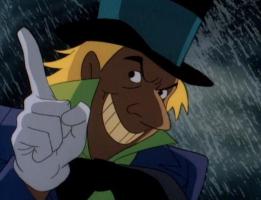 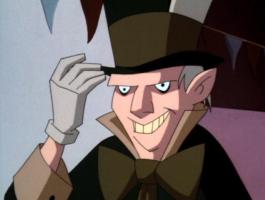
The Mad Hatter
Much like the Riddler, I found the Mad Hatter’s transition from BTAS to TNBA to be underwhelming. In an attempt to make him look more like his comic book counterpart (and, I presume, the Disney version from Alice in Wonderland [1951]), they made him shorter and sickly pale, with white hair, and swapped his outfit with the royal blue trench coat (arguably one of the best BTAS designs) for the dingy green “leprechaun” look. No explanation was ever given for such a radical change, but I believe one could be found in Secret Six: Six Degrees of Devastation miniseries (2006), where Jervis Tetch reveals to the team that he used his mind control technology to hypnotize himself:
It’s an amusing little story, actually. You see, there’s insanity, and then there’s madness. […] It began, as all good stories do, with a lonely man inventing a hat that could rule people’s minds. Oh, delight, such a hat, such a hat! And our intrepid hero used his hat in the cause of justice, or at least enlightened self-interest…and in the pursuit of basic companionship…and even rarer delights still. It seemed there was little joy the hat could not provide. ‘Til one day, one spring sprung morning when I realized I could cut out the middleman. Why use the hat to make others bring me happy thoughts when I could use it to hypnotize myself? I simply tell myself to be delighted, and voila. Those lovely days and nights of bliss, sleeping uncaring in my own filth, as rodents bit at my digits. I weep to think of the joy.
If the DCAU version of the Mad Hatter chose such a path, this could be an explanation for his withered appearance.
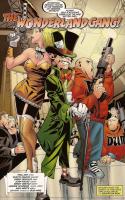
Design notes aside, I could see the Mad Hatter as a major player in the proposed BTAS reboot, primarily as leader of the Wonderland Gang. Debuting in Detective Comics #841 (April 2008), this Paul Dini creation began making appearances in his other stories (such as aforementioned Harley Loves Joker miniseries, Batman: The Adventures Continue [2020]), as well as the Batwoman television series (2019). Featuring an array of top Gotham muscle garbed as Lewis Carroll characters, it wouldn’t take much to imagine Tetch leading a similar group here. This could include the use of well-known members, such as Tweedle Dee and Tweedle Dum, and perhaps some previously-unrelated characters, like Teen Titans villain Cheshire (wearing that mask popularized by the Teen Titans and Young Justice animated shows) and Alice, the villain from Greg Rucka’s runs on Detective Comics (2009-2010) and Batwoman (2011-2013). The latter addition could set the stage for a fracture in the group, with Alice seizing leadership of the Wonderland Gang.
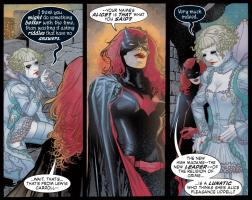
When you break down the Mad Hatter as a character, this version is motivated by unrequited love (and stalking and incel-like behavior, but I digress). Said Dini in the aforementioned interview with Animation Arena (see here):
You look at somebody like the Mad Hatter, who basically is an ugly guy who lives in this dream world and who fantasizes about a pretty co-worker. I based [the Mad Hatter’s first episode, ‘Mad as a Hatter’] on a really tragic story that happened in Silicon Valley about five years ago, about this guy who was a brilliant but shy computer designer and had a fixation on a woman, and he shot everybody in the office. With the Hatter, I made somebody who is technologically brilliant, but who lives in this dream world and was probably ridiculed as a kid; everybody used to call him names because he looked geeky and looked like the Mad Hatter. He actually had a poster of the Mad Hatter up. He liked Alice in Wonderland. When he came up with a way of controlling people, suddenly, they were able to do his will, and he loved it, and he was able to bring his fantasies of Wonderland and living happily ever after to life. But the main reason he did it was he was in love with somebody, and he didn’t want to use that power to control her because he knew that he’d lose her, but ultimately, he had to. That drove him over the edge and drove him crazy, so there’s an element of sorrow to that character—unrequited love taken to the nth degree.
With that in mind, I foresee a storyline where a woman, already familiar with the Hatter’s background, introduces herself to the group as Alice and, using flattery and seduction, takes control of the Wonderland Gang away from Tetch, forcing him to fight to regain leadership.
Sadly, any return of the Mad Hatter would have to deal with the absence of his original voice actor, the late Roddy McDowall. Hopefully a suitable British voice actor can be found to take his seat at the Mad Tea Party.
To be continued…
Click here to discuss this editorial!
Previous installments of "The Possible Return of Batman: The Animated Series":
-Part 1: Why So Reboot?
-Part 2: Rebooting Gotham
-Part 3: The Usual Suspects
Joseph Davis is a regular contributor to the community, having run the Justice League Watchtower website and posting on WF forums under the name "Karkull."
Follow The World's Finest on
YouTube - Twitter - Facebook
 |